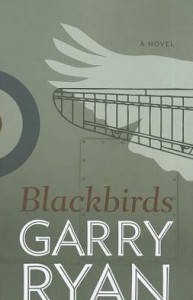Blackbirds is the first in Canadian author Garry Ryan’s series of novels about 18-year-old Sharon Lacey, who goes to England in May 1940 in search of her estranged father. Lacey, who had been taught to fly in the wide open skies of the Alberta prairies, is quickly recruited into the Air Transport Auxiliary (ATA) to ferry aircraft to Royal Air Force (RAF) bases around the country.
The author is best known for his award-winning Detective Lane mystery series set in Calgary. While he has several more of these potboilers in development, Ryan wanted to take a break from murder and return to his other passions: aviation and Second World War history. Nevertheless, this particular style of writing is evident in Blackbirds’ short chapters and punchy sentences, as well as the side stories of family intrigues and British intelligence gathering.
This first book takes us from Lacey’s arrival in May 1940, through the Battle of Britain, up to January 1941. Aviation buffs of this period will appreciate the cameos by RAF Group Captain Douglas Bader, Calgary fighter ace Bill “Willlie” McKnight, and some of the ATA’s top brass, such as Senior Commander Pauline Gower and Gerard d’Erlanger. There are also appearances by the numerous aircraft the ATA were charged with ferrying — from Ansons to Spitfires – and the reader goes on quite the tour of the numerous ATA bases, getting a sense of these pilots’ workload and pace.
Ryan also incorporates a lot of the social history of wartime Britain: blackouts, rationing, absent road signs (to confuse the Nazis), and the impact of bombings on civilians. The author really shines when describing the “walking wounded” of the air war. In addition to Bader, who had lost both legs before the war in an air crash, several characters are afflicted with burns from crack-ups. Ryan sheds light on this aspect of aerial warfare – tannic acid, salt baths, skin grafts – in a sensitive and visceral way.
Of course this is historical fiction, and so Ryan blends fact with hearty doses of imagination. This blending is apparent from the beginning with his character’s names: Sharon Lacey is likely named after James H. “Ginger” Lacey, and her fellow ATA pilot, Linda Townsend after Peter Townsend. Both men were officers with the RAF, whose memoirs Ryan cites as sources. While I appreciate Ryan’s homage to these pilots, and that he includes a list of sources, I was puzzled why he chose male figures and memoirs when ostensibly he wants to elucidate this little-known aspect of women’s participation in the war. There were, after all, a handful of Canadian women who flew overseas for the ATA, including Albertans, and several British women (Diana Barnato Walker comes to mind) have published excellent memoirs.
Like any aircraft, this book has its share of “gremlins.” Keeping in mind that it is destined for a general adult readership (due to the number of expletives), and not rivet counters, Blackbirds is a good entry point into this period of aviation history. For those who prefer their history in fictionalized form – such as the popular new television series Bomb Girls – it could be an enjoyable way to connect with women’s involvement in the Second World War, and the less glorified, but still painfully real, aspects of aerial warfare.












Leave a Reply